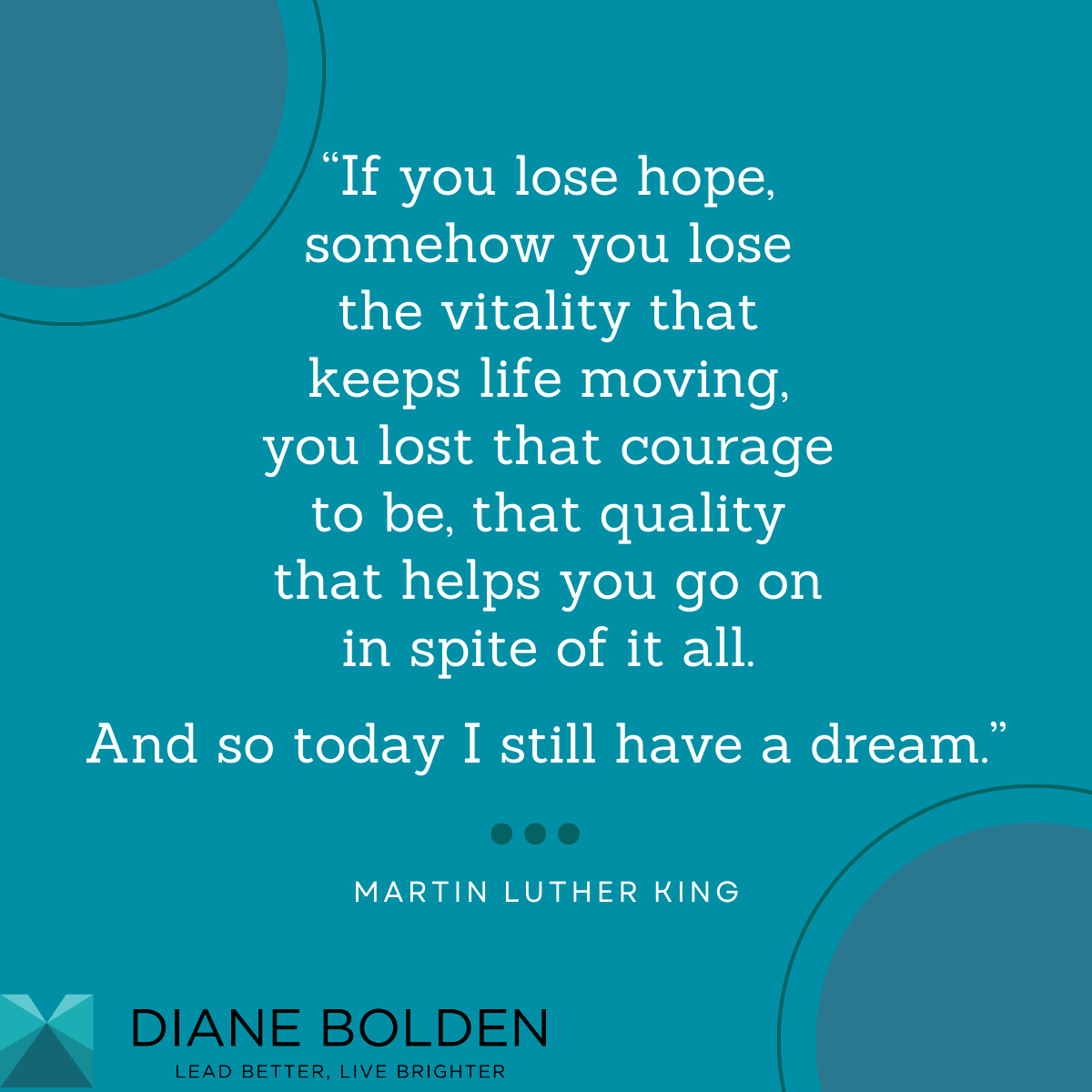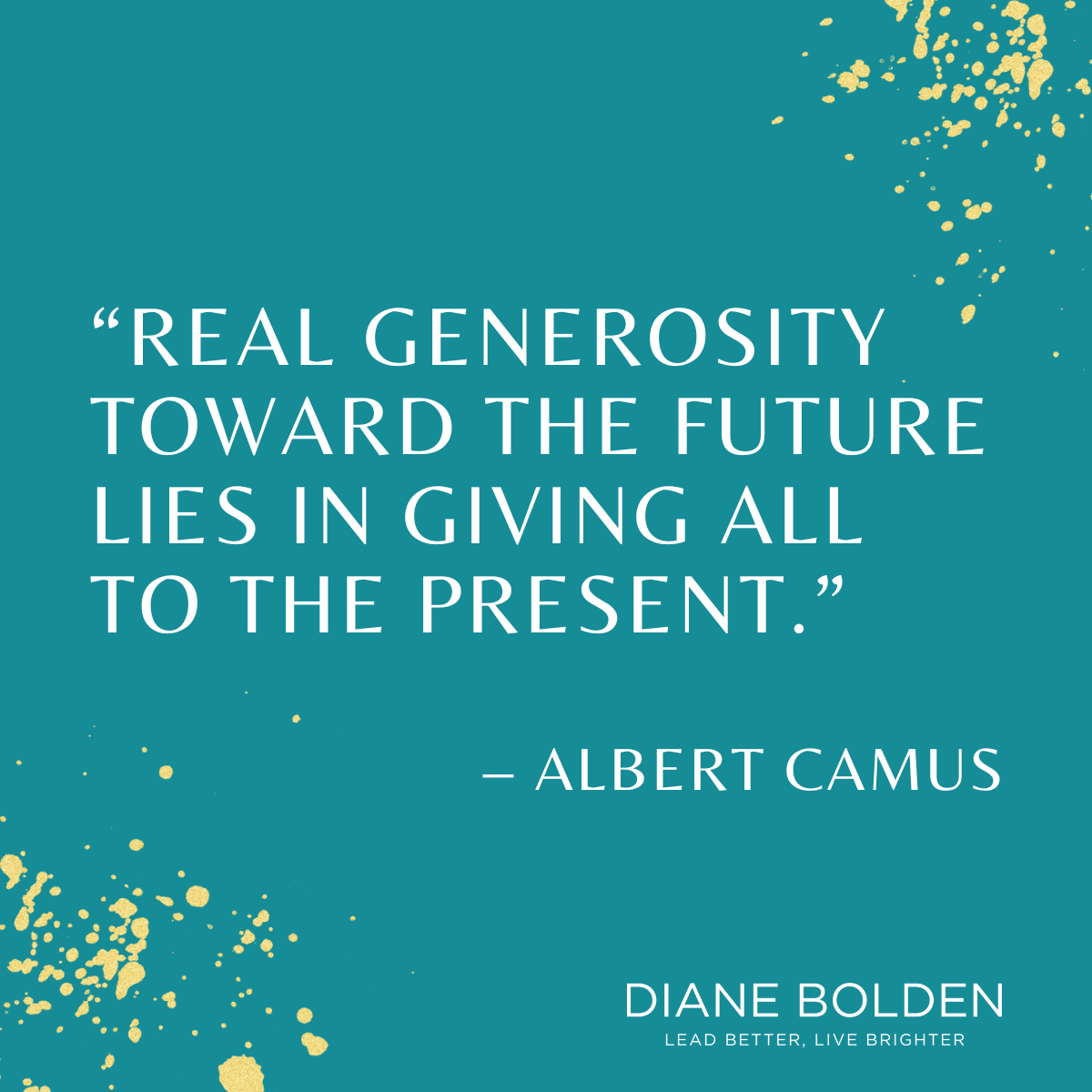Category Archives: Inspiring Yourself & Others
How to Break Out of Overwhelm and Lighten Your Load
Have you ever noticed that your experience directly reflects your state of mind?
When you feel heavy and bogged down, everything you do becomes harder and more cumbersome.
You may think the way you feel is a result of your experiences, and that’s true — the more you have to do, the more overwhelmed you’ll feel. But the reverse also applies — the more overwhelmed you feel, the more you are likely to act in ways that exacerbate it. You might procrastinate, overcomplicate things, or waste energy resisting and worrying.
If you focus on evidence suggesting you’ll never rise above the way you are feeling, you’ll trap yourself in vicious circles where you’ll continue to see what you want to rise above and feel the frustration of being unable to break free.
In fact, your frame of mind with everything you do has a direct effect on whether the experience of doing it will be exhilarating and satisfying or frustrating and heavy.
The stories we tell ourselves have a way of coming true. The way out of the traps we set for ourselves is to start not with our experiences, but our thoughts.
The fundamental shift must come not in what you do, or even how you do it, but what you are thinking, believing and allowing yourself to feel about what you are doing.
To that end, setting an intention or statement of your desired experience can be very powerful. If you want greater freedom and joy, more meaning and satisfaction, and heightened effectiveness, you must align your thoughts around enjoying those experiences before you even start.
And you need to become diligently aware of the degree to which your thoughts stay aligned with your overarching intention. When they drift, you can return to them, remember what you really want, and align yourself with the state you wish to be in again.
In this way, you can break the vicious cycle of allowing your experiences to bring you down in ways that result in more lousy experiences — and begin anew. Your actions align with your thoughts, and you’ll find yourself coming up with creative ways to simplify, get focused on what is most important, and get it done while enjoying yourself in the process – and sharing your joy with everyone around you.
Looking for a better way to lighten your load?
Check out The Pinocchio Principle Unleashed Fast Track: The Real Leader’s Guide to Accessing the Freedom & Flow of Your Authentic Genius, an exclusive 7-week leadership development program designed to help high achieving (and often overextended) leaders minimize pressure and stress so they can access their best work — and enjoy their lives more both on and off the job.
Registration for the fall session is now open! The program will kick off on Friday 9/20 and go through November 1. Visit UnleashtheExtraordinary.com for more information or to reserve your seat.
Try Putting Possibilities Before Pragmatics
 Think big. Ask yourself what the best-case scenario is.
Think big. Ask yourself what the best-case scenario is.
What opportunities have gone unseized?
What possibilities are waiting to be ignited?
If you could wave a magic wand, what would happen?
Then ask yourself what is within your power to create, influence, or lead the charge for.
You don’t have to have all the answers, or even know all the steps.
You just need to start.
For more on creating your vision and taking steps to bridge the gap between where you are and where you want to be, download my special report, “Why Real Leaders Don’t Set Goals (and what they do instead)”
How to Keep Your Goals from Stunting Your Growth
Ask any corporate executive what their goals are, and they’ll likely describe targets they’re shooting for or milestones they aim to hit along the way. Goals are easy – they’re often prescribed or assigned. They’re logical and analytical and concrete.
But ask someone what their vision is, and you’ll likely get a whole different reaction.
Visions are amorphous – they require us to go beyond linear thinking to engage the heart. Vision requires us to check in with what we really want and why – to envision possibilities that we may not yet know how to achieve.
And vision is what activates the energy in people and organizations necessary to persevere through the tough stuff in service to something meaningful and compelling.
If you compare a vision to a goal, it may seem like pie in the sky. Visions are dreamy portrayals of what is possible. Goals on the other hand are rigid and time bound and practically pragmatic. We often place too much emphasis on goals and bypass vision altogether, which leads us to constrain ourselves and put a lid on what we could otherwise conceive and achieve.
What visioning offers that goal setting hinders is the ability to think big. It allows you to transcend what you believe is possible to envision a future without knowing exactly how you will get there.
And that is really important. Because if all you do is what you already know, you will fail to create anything innovative or groundbreaking.
The Wright brothers didn’t know how they would get their creation to fly. NASA didn’t know how to put a man on the moon. Martin Luther King didn’t know how racial equality could be accomplished. In each of these cases, it was a vision that stretched their minds and informed the steps they would take to make their dreams reality.
Vision provides the guiding principle around which actions organize themselves.
It allows us to break out of our little boxes and illuminates answers and possibilities we may not have otherwise seen. We often find these answers as we go along and realize in retrospect that we never could have anticipated them.
Much like a river flows steadily toward the larger body of water that is its ultimate destination, vision propels us forward to find our way through uncertainty and unchartered territory.
A compelling vision identifies not only what you are moving toward, but also why. The bigger why provides you with inspiration you need to move beyond obstacles and other difficulties that would otherwise lead you to abandon your efforts.
You can find your vision with conscious intention and discernment. And if you are diligent in carving out the time to reflect on what is beckoning to you and give it the space to speak, your vision will find you.
For more on creating your vision and taking steps to bridge the gap between where you are and where you want to be, download my special report, “Why Real Leaders Don’t Set Goals (and what they do instead)”.
Harness the Power of Your Heart’s Desire
Consider the essence of what you most want to achieve, create, or become. Perhaps it is not yet concrete, but rather an inkling of something that is calling to you.
Every great accomplishment begins with a dream and a vision. It requires imagination and an openness to receive its gifts. As Albert Einstein once told us, “Imagination is everything. It is the preview of life’s coming attractions.”
And imagination is big and amorphous – it’s not easily captured, quantified, or broken down. It is something that must be welcomed and nurtured. The reward of having done so is that it will reveal itself to you in ways that make you feel alive with possibility.
We are often encouraged to set goals before we even have a vision of what we want to accomplish. But doing so deprives us of the dream that provides the fuel necessary to achieve those goals.
There is wisdom in your desire – even if you cannot yet quantify it, break it down in tangible ways, or even articulate it. In fact, sheer inklings and aspirations can become powerful seeds for the most innovative and ground-breaking accomplishments.
What is your vision? And how can you breathe life into it?
If you’d like more on how to gain the clarity necessary to envision and chart a path to your desired future, download my special report, “Why Real Leaders Don’t Set Goals (and what they do instead)”.
Life is meant for more than checking boxes…
Can you remember the last time you were so excited about something that you could feel the hair on your arms or the back of your neck stand up? Or the giddiness of a five-year-old at the prospect of visiting an amusement park?
Maybe it got you out of bed in the morning or put a little spring in your step.
When the promise of a future state brings a smile to your face or makes your heart beat a little faster, lean in. Give yourself to the dream – and the dream will give itself to you, taking on a life of its own in ways that will surprise and delight you.
Author, philosopher, and civil rights activist Howard Thurman once said, “Don’t ask what the world needs. Ask what makes you come alive and go do it. Because what the world needs is people who have come alive.”
I couldn’t agree more.
What is calling to you right now? And how can you make the space necessary for it to reveal itself to you in all its grandeur?
Sometimes the Smallest Changes Spark the Biggest Transformations
“How do you like your new office?” my friend asked. I had moved from a small building to a larger one and managed to find a nice little space on the second floor at the top of a winding staircase.
It didn’t take long for me to realize it was likely the ONLY small office, surrounded by much larger suites filled with employees of organizations far bigger than my own.
“I love it. It’s beautiful and quiet… Maybe too quiet sometimes,” I added.
My friend looked puzzled.
I missed walking down the halls of my old building, seeing warm smiles on familiar faces, and engaging in an occasional bit of banter.
“It’s strange,” I told her. People don’t seem to make eye contact. Everyone stares straight ahead and silently goes about their business. It’s like an unwritten code or something.”
“An introvert’s dream.” She replied.
She was right. Kind of.
As an introvert myself, I must admit I’m not one who actively seeks conversation. But something was missing. I just wasn’t feeling very connected.
A few days later I was washing my hands in the lady’s room. A woman came out of the stall and proceeded to the sink next to mine. Something welled up in me. Before I knew what I was doing, I heard myself break the silence, suddenly blurting out a clumsy greeting.
“How are you today?”
She looked up, somewhat startled, and stared blankly at me. For a moment, I was reminded of how it felt to be an awkward teenager.
“I’m fine,” she replied after what seemed an eternity. “How are you?”
“I’m great. I’m kind of new here, and I noticed that people don’t really talk to each other much – it’s like an elevator where everyone faces forward and never interacts. And I started to do that too. But I thought it might be nice to try something different today.”
Her face softened, and her eyes brightened. “Yeah, you’re right. I’m just running all the time from thing to thing and so preoccupied.”
“I know that feeling,” I responded, thinking of how many times I was kind of relieved to not have to engage with anyone.
“It really is nice to just be able to talk like yourself, isn’t’ it?” she said.
I found her choice of words interesting. We both relaxed a bit and became a little more conscious. After exchanging names and talking ever so briefly, we each went our way.
And in that moment, the trajectory of my day (and perhaps that of days to come) was changed.
As I reflected on the interaction later, I realized how easy it is for all of us to just take as given the circumstances we find ourselves in – the social norms, the cultural conditioning, the perceived constraints of our day-to-day lives.
Some of those norms serve us. But every once in a while, you might recognize one you’d like to bump up against and challenge in some small, perhaps even unperceivable way.
Do it. You may find you’re not the only one who wants to break through those unwritten rules.
Sometimes the smallest changes spark the biggest transformations – even if only in yourself.
Here’s to busting out of your box!
Performance Management Doesn’t Have to Be Painful
Do you dread doing performance appraisals? (…or any kind of performance management?)
If so, you’re not alone. It’s rarely an experience people look forward to – whether on the receiving, or the giving end. But it doesn’t have to be.
It’s true that many performance appraisal systems don’t do much to motivate and inspire even the strongest of performers (and are often seen as a necessary evil). But if you feel your hands are tied as a result, you will dramatically underestimate the power of your leadership.
Over the years, in the myriad of 360 feedback interviews I’ve done for my executive clients, it almost never fails that at least one (and usually many more) of their directs indicate they would really like to have more feedback, coaching, and mentoring on what they could do better…
Which is interesting – because they don’t just say they want more POSITIVE feedback. They say they want the CONSTRUCTIVE kind too.
They want to know what their leader sees them as capable of achieving – what heights their manager envisions them potentially reaching. And they want to know what they need to do (or stop doing) to close the gap between where they are and where they could be.
These conversations are undoubtedly something that should happen more than once or twice a year. But even if, like many leaders, you have not yet made good on your intentions to have those conversations more often, you can start anytime.
You can start now.
Here are some questions worth considering that can help you turn otherwise unpleasant feedback conversations into valuable ignitors of performance.
- What do you see each of your people capable of achieving?
- What, if anything might they be doing that could get in their way?
- How can you bring limiting behaviors or patterns to their attention in a way that helps them recognize (1) how their current behavior is getting in their way, (2) why making a change will help them to succeed, (3) what they need to do differently, (4) what gives you the confidence they can turn things around?
- What coaching, mentoring, learning/development opportunities, and/or other support can you make available to help them bridge the gap?
Performance feedback conversations don’t have to be a drag.
If you were walking around with a giant weight tied to your back that you didn’t realize you were carrying, you’d be grateful to someone who helped you recognize how to release it. Especially if that person was also able to hold a vision of what you could achieve if you let it go – and where you might be able to go without it.
As a leader, you can do that for other people all day, every day.
Here’s to your success – and your ability to help others succeed too!
Diane
How to Keep Your Dream Alive (despite doubt, hesitation and other obstacles)
Do you have a vision you aspire to make real? No matter what the day/week/month brings… hold strong and continue to breathe life into it. And don’t let your doubt or hesitation steal its fire.
As children, most of us received mixed messages. You may have been encouraged to follow your heart and give life to your dreams in addition to being conditioned to be practical, hedge your bets, and take the safest route. Over time, many of us have allowed the roar of public opinion – that often tells us our dreams are frivolous, selfish, and unlikely to come to fruition – to silence that small still voice within.
But those among us who have risen against their odds have learned to reverse that process and believe in themselves and their dreams despite the overwhelming evidence around them that would suggest that success is improbable.
“If you lose hope, somehow you lose the vitality that keeps life moving, you lost that courage to be, that quality that helps you go on in spite of it all.
And so today I still have a dream.”
~ Martin Luther King
The beginning of each year brings with it the question of what you will focus your time, energy, and resources on accomplishing. It is an optimal time to reacquaint yourself with your dreams and visions, your purpose and values, and the question of how you can become a living example of that which you most admire.
You may be quite sure of what it is you would like to create, do, have, or become. Or perhaps you have only small pieces of a bigger puzzle that has not yet come together.
We all have different talents and strengths, diverse styles and passions – along with a unique combination of experiences (for better or worse) that allows us to discover and apply them to create something bigger than ourselves. You may not know exactly what form it will take, but if you pay attention to the whispers and yearnings of your heart, you’ll begin to make out the shape of something that beckons to you.
The power of your dream will be bolstered by the degree to which your vision expands beyond your own interests to those of others around you. Spend some time contemplating where you feel most drawn and why.
When you land on something that will allow your gifts to align with those of others to accomplish complementary goals, you’ll join forces with something much greater than yourself. It will lift you up when your energy is low and sustain you through moments of doubt and fear.
If you’d like some support in learning how you can leverage your unique style to best connect and collaborate with others to make your vision real, take advantage of a special Happy New Year offer.
For a limited time when you enroll in the Leverage Your Style Behavioral Style Self Study, you’ll have complimentary access to Navigating Change, Challenge & Uncertainty: How to Unleash Extraordinary Performance in Unchartered Territory. Go to www.MeetChangeWithStyle.com for more information (including the curriculum for each course) and to enroll.
You’ll also receive a research-backed, highly validated Target Training International assessment that’ll provide you with a comprehensive 20+ page report about your specific style, including your strengths and areas of opportunity.
Here’s to the power of YOUR dream!
The One Gift Everyone Needs Most (and No One Gets Enough Of)
Regardless of your holiday budget, there’s a gift you can share that transcends all others and won’t cost you a thing. One could argue it’s the one thing that no one gets enough of and everyone needs the most…
It’s the gift of presence, a state that allows us to truly bring out the best in ourselves so that we can do the same for others.
When you give presence, everyone benefits – including you.
You can experience it wherever you are — whether in a meeting, running an errand, sitting at your desk, or in a conversation. It has the power to transform the way you experience your daily life and what it allows you to create for yourself and others — without really DOING anything at all.
Can you recall the last time you felt totally and completely attended to?
Chances are it wasn’t when someone was giving you advice or telling you what to do. It may not have even been when someone was serving you or watching you tear open a gift. Yet when we think of giving something to others our minds often immediately jump to what we can do, say or buy for someone. Many times, the best gift we can give someone is that of our presence.
What exactly is presence?
The word present derives from the Latin past participle praesse meaning “to be before one”. It’s a state of being that’s achieved when you’re truly in the moment, allowing it to unfold without judging it, labeling it, or getting lost in your thoughts about what it means or what you believe should be happening next (or instead).
Presence allows us to cut through the clamor of our preoccupations, worries and fears so that our true selves can emerge. It’s a gateway through which our intuition and inner wisdom enters and expresses itself. A moment of presence is a state of grace that allows us to receive powerful insights that help us make the most of our opportunities and rise to our challenges in creative ways.
It’s a gift that keeps on giving.
In these moments of presence, you’ll experience things on a different level – one that allows you to respond from a deeper, wiser part of yourself. And when you are with others, listening deeply and making them the center of your attention you will bring out that deeper, wiser part of them as well.
This is why the best leaders have learned to become comfortable with silence, to listen more than they talk, and to allow themselves to become instruments that help others to recognize their own greatness – not necessarily through anything that say or do, but rather through moments of presence that are created and shared with others.
In a world where everything moves so fast and people often feel overlooked and unheard, presence is one of the greatest gifts you can give.
It has the capacity to transform ordinary everyday life into precious moments that’ll become treasured memories. And since it’s a gift that’ll give as much to you as it will to others, it makes giving as wonderful as getting – no matter the time of year.
Here’s to your presence! Wishing you and yours a beautiful holiday.
It’s Not What You Do – It’s the Way that You Do It…
Ahh December. Twinkle lights on trees and rooftops, the smell of wood burning in fireplaces, a refreshing chill in the air… and of course, a whole slew of things to do that can tip the scales for people who were already feeling overwhelmed with work (and maybe even life itself).
How You Do Things is as Important as What You Do (…maybe even more so)
It’s tempting to approach all those things the way you do items on a checklist – just power through them in the most efficient way possible. The risk of that, however, is that you’ll relegate yourself to a kind of “autopilot” state, where you’re going through the motions with your head and your hands but not really your heart.
And when that happens, the things you do can feel empty – for yourself and others too.
Never Underestimate the Power of Presence
I’m convinced that when people receive what we give them, they experience the energy we put into it. You’ve probably had someone tell you to have a good day while looking at their phone or multi-tasking. It just doesn’t have the same impact as it does when they look you in the eye and are truly with you, sharing a feeling and not just words that sound good.
The end of the year brings into focus what really matters in our lives.
November leads us to think about what we are grateful for. December allows us to spend time with those we love, both giving and receiving in ways that create and perpetuate joy. And as we move closer to January, we do well to reflect on what we most want to experience, accomplish, or become in the new year.
It’s a time that calls us to be present – and to pour our very selves into what matters most.
Honor What’s Most Important
You may not be able to DO everything on your list (most of us never really can). Instead, take some time to identify what is really important to you.
What are the things you care so much about that it’s worth slowing down to pour enough of yourself into them that people are moved by the experience? Those things you give yourself to wholeheartedly will be the game changers in both your personal and your professional life.
So be intentional. Start now. Today.
What matters most to you? And how can you be completely present and intentional in a way that allows others to truly experience the magnitude of what you have to offer?
Because when you do, what you give to others will enrich your own life as much as it does theirs.










